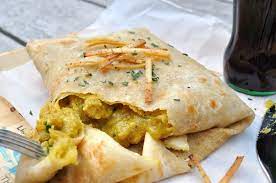West Indian Cuisine in the Virgin Islands: A Flavorful Journey
The Virgin Islands, a tropical paradise in the Caribbean, are not only celebrated for their stunning beaches, azure waters, and vibrant culture but also for their rich and diverse culinary heritage. The islands’ unique blend of West Indian cuisine is a delectable reflection of the region’s history, culture, and natural bounty. In this exploration, we will embark on a flavorful journey through the tastes and traditions of West Indian cuisine in the Virgin Islands.

Saltfish and dumplings
Historical Influences:
The West Indian cuisine in the Virgin Islands is a tapestry woven with the threads of various cultures, including African, Spanish, Dutch, French, and British. The islands were once a hub of the transatlantic slave trade, resulting in the melding of African flavors and culinary techniques with European ingredients and influences. This historical fusion laid the foundation for the eclectic flavors found in Virgin Islands cuisine.
Key Ingredients:
- Seafood: The Virgin Islands’ location amidst the Caribbean Sea makes seafood an integral part of their cuisine. Freshly caught fish, lobster, conch, and shrimp are often prepared with spices and local herbs, creating mouthwatering dishes like “conch fritters” and “fish in creole sauce.”
- Root Vegetables: Yams, sweet potatoes, and cassava are staples in many Virgin Islands dishes. They are often boiled, roasted, or fried, and their earthy sweetness provides balance to the spiciness of many West Indian dishes.
- Coconut: Coconut milk and shredded coconut are frequently used in both savory and sweet dishes, adding a rich, tropical flair. Coconut rice and “coconut tart” are popular examples.
- Spices and Seasonings: West Indian cuisine is known for its bold and aromatic spices. A blend of spices known as “Bouké” is essential, featuring flavors like thyme, garlic, onion, and Scotch bonnet peppers, which provide that signature kick.
- Fruits: The islands are blessed with a variety of fruits such as mangoes, papayas, guavas, and passion fruit. These fruits are not only consumed fresh but also used in chutneys, salsas, and drinks.
Popular Dishes:
- Callaloo: A hearty and nutritious soup made from leafy greens, often seasoned with salted pork or crab.
- Roti: A Caribbean flatbread filled with curried vegetables, meat, or seafood, offering a satisfying and portable meal.
- Johnny Cake: A sweet or savory deep-fried dough that is a popular snack and side dish.
- Saltfish and Dumplings: Salted codfish is simmered with dumplings and seasoned with herbs and spices, creating a comforting and hearty meal.
- Pate: A flaky pastry filled with spiced meat or vegetables, reflecting the European influence on local cuisine.
- Mofongo: A Puerto Rican-inspired dish made from mashed and fried plantains, often paired with seafood or meat.
- Black Cake: A rich and dense fruitcake soaked in rum, a classic dessert enjoyed during the holiday season.
Culinary Techniques:
West Indian cuisine in the Virgin Islands places a strong emphasis on slow cooking and simmering, which allows the flavors to meld and intensify. Marinating and seasoning are integral to the process, often involving complex spice mixtures. Grilling and frying are also popular methods for preparing meat and seafood, providing a contrast of textures and flavors.

The Roti is a popular dish typically made with chicken or goat meat
Cultural Significance:
Food plays a pivotal role in the culture of the Virgin Islands. Traditional dishes are often prepared and enjoyed during various cultural celebrations and events, showcasing the importance of communal dining. The islands’ lively festivals, such as Carnival and St. John Festival, feature an array of street food vendors, offering a taste of the local culinary delights to residents and visitors alike.
Moreover, the practice of passing down recipes from generation to generation is a cherished tradition, strengthening family bonds and preserving the unique culinary heritage of the islands. Through the act of sharing meals and recipes, the Virgin Islands maintain a strong connection to their history and cultural identity.
Modern Trends:
While the Virgin Islands remain deeply rooted in their culinary traditions, modern influences have also shaped their cuisine. As tourism has grown, the islands have embraced fusion cuisine, incorporating international flavors and techniques to create innovative and diverse dishes. For instance, you can find Caribbean-inspired sushi or gourmet twists on classic West Indian dishes in upscale restaurants.
The farm-to-table movement has also made its mark, with an increasing focus on sourcing local, fresh ingredients. This not only supports the local economy but also enhances the quality and authenticity of West Indian dishes.
Challenges and Sustainability:
The delicate ecosystems of the Virgin Islands face various challenges, including the effects of climate change and unsustainable fishing practices. Rising sea levels, more intense hurricanes, and coral reef degradation threaten the very resources that underpin West Indian cuisine.
Efforts are underway to promote sustainable practices in the culinary industry. Local organizations work to educate both residents and visitors about the importance of preserving the environment and supporting sustainable fishing and agriculture.
In Conclusion:
West Indian cuisine in the Virgin Islands is a captivating fusion of history, culture, and the bounties of the Caribbean. From aromatic spices to the freshest seafood and tropical fruits, the islands offer a tantalizing experience for the palate. This culinary tradition is more than just food; it’s a celebration of the region’s rich history and a testament to the enduring spirit of the Virgin Islands. As the islands continue to evolve, the legacy of West Indian cuisine will remain a defining element of this breathtaking paradise in the Caribbean.
